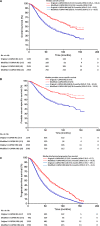Modified J-CAPRA scoring system in predicting treatment outcomes of metastatic prostate cancer patients undergoing androgen deprivation therapy
- PMID: 33098372
- PMCID: PMC7774710
- DOI: 10.1002/cam4.3548
Modified J-CAPRA scoring system in predicting treatment outcomes of metastatic prostate cancer patients undergoing androgen deprivation therapy
Abstract
The J-CAPRA score is an assessment tool which stratifies risk and predicts outcome of primary androgen deprivation therapy (ADT) using prostate-specific antigen, Gleason score, and clinical TNM staging. Here, we aimed to assess the generalisability of this tool in multi-ethnic Asians. Performance of J-CAPRA was evaluated in 782 Malaysian and 16,946 Japanese patients undergoing ADT from the Malaysian Study Group of Prostate Cancer (M-CaP) and Japan Study Group of Prostate Cancer (J-CaP) databases, respectively. Using the original J-CAPRA, 69.6% metastatic (M1) cases without T and/or N staging were stratified as intermediate-risk disease in the M-CaP database. To address this, we first omitted clinical T and N stage variables, and calculated the score on a 0-8 scale in the modified J-CAPRA scoring system for M1 patients. Notably, treatment decisions of M1 cases were not directly affected by both T and N staging. The J-CAPRA score threshold was adjusted for intermediate (modified J-CAPRA score 3-5) and high-risk (modified J-CAPRA score ≥6) groups in M1 patients. Using J-CaP database, validation analysis showed that overall survival, prostate cancer-specific survival, and progression-free survival of modified intermediate and high-risk groups were comparable to those of original J-CAPRA (p > 0.05) with Cohen's coefficient of 0.65. Around 88% M1 cases from M-CaP database were reclassified into high-risk category. Modified J-CAPRA scoring system is instrumental in risk assessment and treatment outcome prediction for M1 patients without T and/or N staging.
Keywords: advanced prostate cancer; overall survival; progression-free survival; risk stratification; treatment response.
© 2020 The Authors. Cancer Medicine published by John Wiley & Sons Ltd.
Conflict of interest statement
All authors declare no conflict of interest.
Figures


References
-
- GLOBOCAN 2018: Estimated cancer incidence, mortality and prevalence worldwide in 2018. http://gcoiarcfr
-
- Summary of Malaysian National Cancer Registry Report 2007–2011. http://ncimohgovmy
-
- Huggins C, Hodges CV. Studies on prostatic cancer. I. The effect of castration, of estrogen and androgen injection on serum phosphatases in metastatic carcinoma of the prostate. Cancer Res. 1941;1:293‐297. - PubMed
Publication types
MeSH terms
Substances
LinkOut - more resources
Full Text Sources
Medical
Miscellaneous

